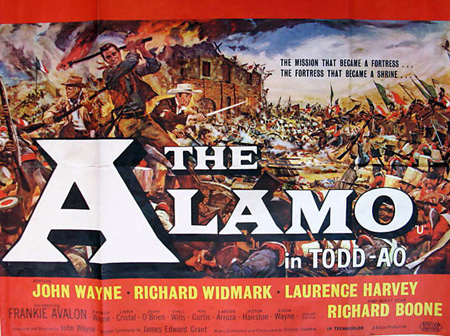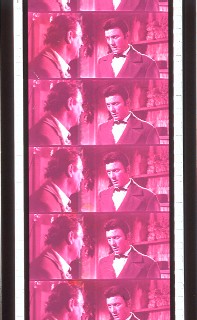An Update On The Long Version |
Read more
at in70mm.com The 70mm Newsletter |
| Written by: Ashley Ward, July 15, 1991 | Date: 01.06.2009 |
 British
quard poster from London premiere from Mr Maurice Jones, Wales, United
Kingdom British
quard poster from London premiere from Mr Maurice Jones, Wales, United
Kingdom"Well, there she be Davy, after thirty years of hard ridin'." I wish that I had been clever enough to have said these words, but I was speechless. Last November 24th, David Mocniak and I arranged a screening of the fabled 70mm long version of “The Alamo”. I didn’t come back down to earth for quite a few days thereafter. This eventuality has been a driving force in my life for thirty years. The first thing to be said is that the print would never have been located without crucial information from Bob Bryden. The screening itself was supported by Murray Weissmann and Kipp Martin. David Mocniak and I thank you all. Last year I wrote an article which insisted that the only way to see the film was in a theater. I was wrong. The only way to see “The Alamo” is in Todd-AO, in a really big theater. The picture was so sharp and bright that we could see the pores in the actors' faces and the stitching in their clothing. The picture was even sharper than “Price Of Freedom” (in IMAX)! The six-track Westrex magnetic stereo sound was every bit as impressive as that of the IMAX presentation. The projectionist cranked the sound up as high as it would go. We were able to hear breathing; leather shoes squeaking; the wind blowing; voices echoing; and clothes rustIing. Dimitri Tiomkin's score was never better. I have had the pleasure of examining the Todd-AO recording Iogs and the care and craft that went into creating this sound track is amazing. After accustoming ourselves to the brilliance of the 70mm picture, the depth of the sound, and the presumed last scenes, we realized an added bonus. The original version was edited differently than the 161 minute print we are familiar with. Many scenes have additional footage at the beginning and end, while others are edited in a different order of scenes. There are numerous short scenes without any dialougue which don' t appear in the short version. These are most evident in the final thirty minutes of the film. |
More
in 70mm reading: "The Alamo" lost 70mm version - This letter which started it all The Finding Of The Lost Alamo Remember the Alamo? November 24, 1990: In Retrospect I Was There There are two things which have tormented me for most of my adult life One Morning In November The Reconstruction and Restoration of John Wayne's "The Alamo" Internet link: "The Alamo" articles and letters appeared in "The Spirit of the Epic" magazine in June 1990. Reprinted here with permission from Robert Bryden bobbryden.com |
 Ashely
F. Ward's letter decorated with "The Alamo" logo. Ashely
F. Ward's letter decorated with "The Alamo" logo.The first difference is the Todd-AO credit. It appears between those for James Edward Grant and William H. Clothier and has the same background painting as the latter. Watching the Todd-AO picture, one sees more information at the top, bottom and at both sides of the screen. The 35mm prints give the illusion of a wider image by cropping the top and bottom of the frame. We were literally seeing a different film just by virtue of the edges. The smallest of the credits which are illegible on television were as sharp and clear as if they were in front of our faces. I was sceptical right up to the appearance of the first cut scene (in Bowie's room). After seeing it, you could have knocked me over with a feather. As each of these fabled scenes appeared, I experienced a catharsis. I had remembered Emil Sand's death from 1960, and it was the most exciting of those to reappear. The intermission is introduced with a painting which is different from that used in the home video product. It is an oblique view of the interior of the low barracks, to the left of the main gate. It is crucial to emphasize the most important of the cut scenes. Crockett's prayer, which follows the Parson's death is important in giving depth to Crockett's character. I defy anyone to sit through it with a dry eye. It is also one more example of what a fine actor Wayne really was. |
|
"We haven’t had many conversations, Sir. Only time I've ever called on you was when I wanted something... when I was in a tight, like a little boy hollerin' for his Pa. Now I want something again. I brought these men down here without askin' 'em did they want a piece of this war. That's a failing of mine, deciding' for others. So, if you could find it clear to let these men live through this battle, I'd be forever thankful. But if your stick don't float that way, please to remember, Sir, these are good men, all." |
|
 Faded
70mm clip from a Swedish 70mm print Faded
70mm clip from a Swedish 70mm printThe preponderance of additional scenes begins the night before the final assault. There are a half dozen or more shots of members of the garrison conteroplating their fate. Several groupings by the cattle pen are noticeable, while another includes Silverio Seguin! The last of the cut scenes with dialogue is here. It involves Guinn Williams' protestations of faith. This precedes that of John Dierkes. Unfortunately, Jester Heston's rendition of "The Green Leaves of Summer" is not present. Obviously, this scene ended up on the cutting room floor at an earlier stage. The additional scenes provide for a longer rendition of the above song than in the short print. The first shot at dawn the following day is of the chapel and the lone sentry. At the far right side of the palisades one can see a Cadillac ambulance for two seconds. At the beginning of the assault, the short version presents three close-ups of Mexican officers ordering the advance. In the original version, there is a fourth such close-up. The scenes which follow include more of the defenders firing and of the Mexicans dying. Laurence Harvey has more screen time at this post on the north wall. The scenes of Guinn Williams' death, the explosion of a cannon, and opening the breach in the wall are much more protracted. The beginning of the Mexican grenade sequence is longer as well. |
|
 Advert
from The International Motion Picture Alamanac 1959. Advert
from The International Motion Picture Alamanac 1959.Of satisfaction to me is the manner of editing Chill Wills' death. In the short version, this scene is intercut with that of the dragoons vaulting the north wall. This basic error in editing breaks the continuity of Wills' agonizing last moments. The original version made no such blunder and Wills' death unreels uninterrupted. The final push over the barricade has many more shots of Mexican troops climbing and jumping down than does the short print. The most exciting of these little scenes, and a complete revelation to me, was Davy Crockett's death. It is significantly longer in the original. As Crockett lifts himself off the broken lance, he staggers forward, and then falls backward. These two differences aren't in the popular version of the film. The survivors' exodus from the Alamo is longer than in the short print. There are more shots of Mexicans and Joan O'Brien's reactions in the original. The ultimate irony of viewing the original after all these years is that its pacing is faster than the shorter version. The general release version was created to pick up the pace of what was considered a slow film (not to mention allowing one additional screening each day). In so doing, they made a slower uneven film which has contributed negatively to the public's remembrance of the film. The original 70mm version, aside from being a treat for the senses, is actually a very good film. Developments since last November are varied in their desirability. The 70mm print is in Los Angeles and is being looked after. However, MGM-Pathe feels that restoring it a la “Lawrence of Arabia” and “Spartacus” would not be cost effective. It is not practical to expect them to cngage in a losing proposition (I suppose). They have sent it to Turner Entertainment however, for duplication of the missing dialogue scenes, albeit in 35mm. This leaves the myriad examples of little scenes (and Crockett's longer death) inaccessible, not to mention the advantages of seeing (and hearing) the film in Todd-AO. The stated intent is to make up at least one new 35 MM print with the additional scenes and subsequently release this on tape and disc. This is somewhat of a mixed blessing. Will you be able to see the original version of “The Alamo” again? Yes and No. The additional scenes will no doubt be a revelation, just as last year's release including the roadshow music. The recently restored (partially) “It's a Mad Mad Mad Mad World” was mastered from the 70mm print for home video release. Why can't MGM-Pathe accord our film the same advantage? |
|
|
Go: back
- top - back issues
- news index Updated 22-01-25 |
|
